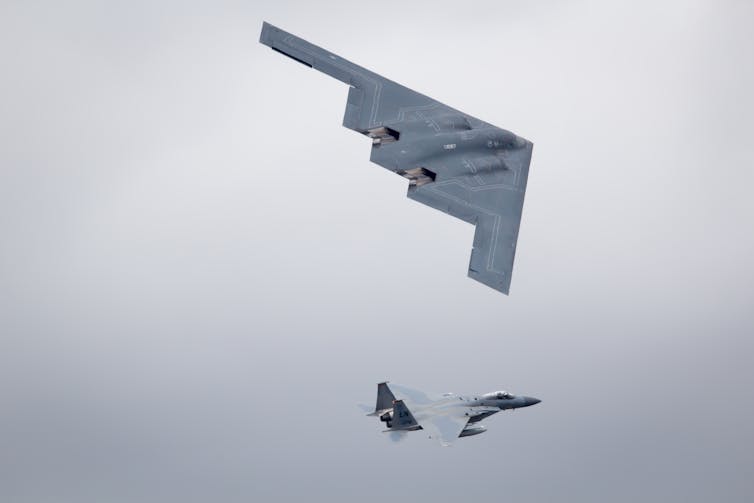by Dan Plesch
When it comes to estimating military capability, the Western media is principally concerned with the weapons capabilities of weaker states - and it rarely pays much attention to the colossal capability of the US, which still accounts for most of the world’s defence spending.
Any sensible discussion of what a hypothetical World War III might look like needs to begin with the sheer size and force of America’s military assets. For all that China and Russia are arming up on various measures, US commanders have the power to dominate escalating crises and counter opposing forces before they can be used.
Take missile warfare alone. The US Navy already has 4,000 Tomahawk cruise missiles, and the Navy and Air Force are currently taking delivery of 5,000 JASSM conventional cruise missiles with ranges from 200-600 miles. Barely visible to radar, these are designed to destroy “hardened" targets such as nuclear missile silos. Russia and China, by contrast, have nothing of equivalent quantity or quality with which to threaten the US mainland.
The same holds true when it comes to maritime forces. While much is made of Russia’s two frigates and smaller vessels stationed off the Syrian coast, France alone has 20 warships and an aircraft carrier in the Mediterranean - and US standing forces in the area include six destroyers equipped with scores of cruise missiles and anti-missile systems. At the other end of Europe, the Russian military is threatening the small Baltic states, but it is rarely noted that the Russian Baltic fleet is the same size as Denmark’s and half the size of Germany’s.
Meanwhile, China’s aggressively expansionist behaviour in the South China Sea is reported alongside stories of its first aircraft carrier and long-range ballistic missiles. But for all that the Chinese navy is large and growing, according to the International Institute for Strategic Studies, it’s still only numerically equivalent to the combined fleets of Japan and Taiwan, while the US boasts 19 aircraft carriers worldwide if its marine assault ships are included.
But overhanging all this, of course, is the nuclear factor.
Out of the sky
The US, Russia and China are all nuclear-armed; Vladimir Putin recently unveiled a new fleet of nuclear-capable missiles which he described as “invincible in the face of all existing and future systems", and some have suggested that China may be moving away from its no-first-use policy. This is all undeniably disturbing. While it has long been assumed that the threat of nuclear weapons acts as a deterrent to any war between the major powers, it’s also possible that the world may simply have been riding its luck. But once again, the US’s non-nuclear capabilities are all too often overlooked.
US leaders may in fact believe they can remove Russia’s nuclear deterrent with an overwhelming conventional attack backed up by missile defences. This ability was cultivated under the Prompt Global Strike programme, which was initiated before 9/11 and continued during the Obama years. Organised through the US Air Force’s Global Strike Command, it is to use conventional weapons to attack anywhere on Earth in under 60 minutes.
This is not to say the task would be small. In order to destroy Russia’s nuclear missiles before they can be launched, the US military would need to first blind Russian radar and command and communications to incoming attack, probably using both physical and cyber attacks. It would then have to destroy some 200 fixed and 200 mobile missiles on land, a dozen Russian missile submarines, and Russian bombers. It would then need to shoot down any missiles that could still be fired.
Russia is not well positioned to survive such an attack. Its early warning radars, both satellite and land-based, are decaying and will be hard to replace. At the same time, the US has and is developing a range of technologies to carry out anti-satellite and radar missions, and it has been using them for years. (All the way back in 1985, it shot down a satellite with an F15 jet fighter.) That said, the West is very dependent on satellites too, and Russia and China continue to develop their own anti-satellite systems.
The air war
Russia’s bomber aircraft date back to the Soviet era, so despite the alarm they provoke when they nudge at Western countries’ airspace, they pose no major threat in themselves. Were the Russian and US planes to face each other, the Russians would find themselves under attack from planes they couldn’t see and that are any way out of their range.
US and British submarine crews claim a perfect record in constantly shadowing Soviet submarines as they left their bases throughout the Cold War. Since then, Russian forces have declined and US anti-submarine warfare has been revived, raising the prospect that Russian submarines could be taken out before they could even launch their missiles.
The core of the Russia’s nuclear forces consists of land-based missiles, some fixed in silos, others mobile on rail and road. The silo-based missiles can now be targeted by several types of missiles, carried by US planes almost invisible to radar; all are designed to destroy targets protected by deep concrete and steel bunkers. But a problem for US war planners is that it might take hours too long for their missile-carrying planes to reach these targets - hence the need to act in minutes.

The US’s B-2 Spirit stealth bomber. AMMHPhotography via Shutterstock
One apparently simple solution to attacking targets very quickly is to fit quick nuclear ballistic missiles with non-nuclear warheads. In 2010, Robert Gates, then serving as secretary of defence under Barack Obama, said that the US had this capability. Intercontinental ballistic missiles take just 30 minutes to fly between the continental US’s Midwest and Siberia; if launched from well-positioned submarines, the Navy’s Tridents can be even quicker, with a launch-to-target time of under ten minutes.
From 2001, the US Navy prepared to fit its Trident missiles with either inert solid warheads - accurate to within ten metres - or vast splinter/shrapnel weapons. Critics have argued that this would leave a potential enemy unable to tell whether they were under nuclear or conventional attack, meaning they would have to assume the worst. According to US Congressional researchers, the development work came close to completion, but apparently ceased in 2013.
Nonetheless, the US has continued to develop other technologies across its armed services to attack targets around the world in under an hour - foremost among them hypersonic missiles, which could return to Earth at up to ten times the speed of sound, with China and Russia trying to keep up.
Missile envy
The remainder of Russia’s nuclear force consists of missiles transported by rail. An article on Kremlin-sponsored news outlet Sputnik described how these missile rail cars would be so hard to find that Prompt Global Strike might not be as effective as the US would like - but taken at face value, the article implies that the rest of the Russian nuclear arsenal is in fact relatively vulnerable.
Starting with the “Scud hunt" of the First Gulf War, the US military has spent years improving its proficiency at targeting mobile ground-based missiles. Those skills now use remote sensors to attack small ground targets at short notice in the myriad counter-insurgency operations it’s pursued since 2001.

An Aegis Ashore Missile Defence System under the US flag in Europe.EPA/Robert Ghement
If the “sword" of Prompt Global Strike doesn’t stop the launch of all Russian missiles, then the US could use the “shield" of its own missile defences. These it deployed after it walked out of a treaty with Russia banning such weapons in 2002.
While some of these post-2002 missile defence systems have been called ineffective, the US Navy has a more effective system called Aegis, which one former head of the Pentagon’s missile defence programs claims can shoot down intercontinental ballistic missiles. Some 300 Aegis anti-ballistic missiles now equip 40 US warships; in 2008, one destroyed a satellite as it fell out of orbit.
War mentality
In advance of the Iraq war, various governments and onlookers cautioned the US and UK about the potential for unforeseen consequences, but the two governments were driven by a mindset impervious to criticism and misgivings. And despite all the lessons that can be learned from the Iraq disaster, there’s an ample risk today that a similarly gung-ho attitude could take hold.
Foreign casualties generally have little impact on domestic US politics. The hundreds of thousands of Iraqi civilians who died under first sanctions and then wardid not negatively impact presidents Clinton or George W. Bush. Neither might the prospect of similar casualties in Iran or North Korea or other states, especially if “humanitarian" precision weapons are used.
But more than that, an opinion poll run by Stanford University’s Scott Sagan found that the US public would not oppose the preemptive use of even nuclear weapons provided that the US itself was not affected. And nuclear Trident offers that temptation.
The control of major conventional weapons as well as WMD needs urgent attention from international civil society, media and political parties. There is still time to galvanise behind the Nobel-winning International Campaign to Abolish Nuclear Weapons and the nuclear ban treaty, and to revive and globalise the decaying arms control agenda of the Organisation for Security and Co-operation in Europe, which played a vital part in bringing the Cold War to a largely peaceful end.
 Like the Kaiser in 1914, perhaps Trump or one of his successors will express dismay when faced with the reality a major US offensive unleashes. But unlike the Kaiser, who saw his empire first defeated and then dismembered, perhaps a 21st-century US president might get away with it.
Like the Kaiser in 1914, perhaps Trump or one of his successors will express dismay when faced with the reality a major US offensive unleashes. But unlike the Kaiser, who saw his empire first defeated and then dismembered, perhaps a 21st-century US president might get away with it.
Dan Plesch, Director of the Centre for International Studies and Diplomacy, SOAS, University of London
This article was originally published on The Conversation. Read the original article.
No comments:
Post a Comment